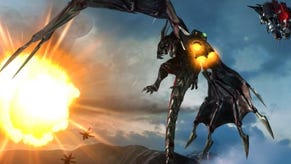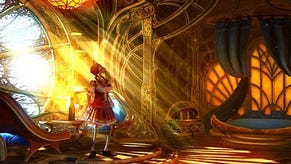Diviner Divinity: Dragon Commander Preview
"The one where you marry a skeleton"
If I hadn’t spent an hour playing Saint’s Row: The Third, Larian Studios’ Dragon Commander would comfortably be the oddest game I saw at Gamescom. It’s not odd through and through, however – in fact it’s a focused, ambitious and visually gorgeous brew of roleplaying, strategy and aerial combat, with all manner of batshit silliness peppered about its surface.
It’s already found some notoriety due to the decision to feature a dragon fitted with a jetpack. Smiles Farhang Namdar, lead game designer, “that caused a lot of comments on your site!” It is, however, a decision I am 100% behind. It looks great, it justifies the roaring speed that dragon is capable of, and it makes Dragon Commander instantly distinctive, not rote fantasy. There's so much more going on than improbable dragon mobility aids, however.

A tinge of similarly good-natured weirdness can be found throughout. While the whizzbang element of Dragon Commander is the sky-battles, pitching you as the titular character, transformed into a giant, black, jetpack-adorned dragon, battling steampunky floating turrets and vast flying armies, the metagame is the gradual conquest of the land’s kingdoms. For that, you’ll need alliances as well as well as onslaught.
Namdar’s commander has recently arranged one such alliance, by marrying a rival kingdom’s princess. We stride to the royal bedchamber, where a shapely figure awaits. The shapely figure turns around. We try not to stare at the lipstick smeared across its fleshless face, the two large apples shoved unconvincingly into a corset worn straight over a bare ribcage. The skeleton princess is delighted to see us. She asks if we’re ready to consummate the marriage. Um. Issues of arousal aside, purely on a practical level, how would that work? No, best not to imagine or… Oh God, the mental image. Out, out, out!
So: business before pleasure, m’dear. There’s a realm to be conquered. The princess duly switches to politics, and a taste of the kind of metagame dilemmas Dragon Commander will offer. The undead, currently your allies due to this marriage, are a strong military force but currently lacking their own home city. They’ve got their eye on one, however, primarily because there are some necromancers in the area who could help restore them to a higher standard of unlife. Unfortunately, the city of Deepspire already belongs to the dwarves. Turfing those fellows out wouldn’t be a good move politically, but it would mean the undead will fight by your side in the next battle… What to do, what to do?
This is, Namdar claims, the kind of decision you’ll be making regularly – long-term versus short-term gains, deciding who the most ultimately useful ally is, bearing in mind the roleplaying consequences (such as marriages) and, well, just how much of a dick you want to be. “You’re always choosing between what you want, what the princess wants, what’s good for your nation, what’s simply wise…” Oh, and there’ll be multiple princesses in the game – you’ll marry the one you think is most politically useful. If another one becomes more politically useful later… Well, it’s amazing how easy it is for people to trip over and plunge to their doom when they’re living on a floating fortress. Henry VIII doesn’t have a monopoly on multi-matrimony, y’know.
A raft of advisors are available on said lavishly-rendered floating fortress, within which this RPG-esque element of the game is based. Civ-style, they can offer some pros and cons for which decisions to take next, what to focus your resources on. In this case, it’s looking like the dwarves are about to become homeless. Bad luck, dwarves. Your reward, however, is a new Card - Undead Allies. This, essentially, translates to a bonus squadron of sky-bound death dealing in your next big fight.
So where shall that next fight be? Time to peer at the second major game-style, the world map. This plays out like a boardgame – in fact, Namdar physically built a boardgame version of it and “made sure everyone really loved it before we put it into the game.” Think along the lines of Small World – territories occupied by assorted fantasy races, each offering different bonuses or resources. It’s more elaborate than that, however , as you’re not simply trying to grab everything, but to prioritise which zones are most useful. Territories with factories in will enable you to purchase additional units, but perhaps you need somewhere that’s more gold-rich to be able to afford said units. And, of course, some areas will be harder to nab than others.
Time for a fight, then. From your hand of cards and roster of generals, you’ll need to pick what you think is going to be most useful for this particular engagement. Those Undead Allies are definitely along for the ride, and it’s probably worth throwing in some Imp Busters – fireball spells that pack an equivalent punch to a small nuke. Your various generals, each heading up their own squadron, have different combat styles and abilities – for instance, one might attack head-on, full-force, another might be better suited to spells or flanking.
For the fight, the game switches from the turn-based strategy of the world map to real-time aerial combat, like Crimson Skies with dragons and vast floating castles. It looks incredible, the skies filled with units and structures (one flying building looks like one of the Tron’s Recognizers as designed by Khorne) and fire, yet Namdar reckons this is only a very rough, nuts and bolts version of the game. The finished product will feature tons of stuff on the ground and even more units – plus rival dragons. You’re in control of your own dragon from a third-person perspective, that blessed jetpack allowing you to quickly traverse vast tracts of the 20x20km map.
Everything you played as cards is visible in the fight – there’s your undead allies now. You can dole out orders, tell your squadrons what to attack or when to flee, but you’re only in direct control of yourself. It’s spectacular stuff to behold, and apparently highly-tactical too. You can try to play it as an all-out, third-person action affair if you like, but alternatively you could concentrate on giving orders, focusing on flanking, supporting and reinforcing, playing it as a sort of fantasy Homeworld.
It’s a long, long way away from - and I'd say above - Divine Divinity, despite being based in a chronologically earlier version of the same universe. It’s trying to pull off an awful lot, but in a Gamescom characterised by shooters seeing something with such a core vein of strategy in there but not scrimping on the presentation makes it stand out a mile. I liked Dragon Commander here an awful lot, and not purely because of rocket-boosted dragons and icky skeletal romance. Can't wait to see more of this one.


















